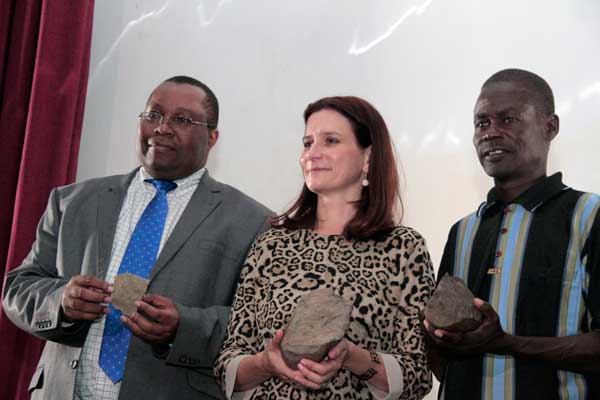Kenya is arguably the country in with the
highest number of human evolution fossils. In particular, the region
near Lake Turkana has been very fertile ground for the discovery of
human evolution fossils and artifacts. Below is a listing, description
and background information about the Human evolution fossils unearthed
in Kenya.
The world’s oldest stone tools
In 2011 a research team led by Dr Sonia
Harmand of Stony Brook University, discovered a set of stone tools at a
site called Lomekwi on the Northern shores of Lake Turkana. The tools
were found by Sammy Lokorodi.

Dr Mzalendo Kibunja of the Kenya Museums, , Stony
Brook University research associate professor Dr Sonia Harmand and Sammy
Lokorodi
The tools were found to be 3.3 million years
old, which is 700,000 years older than the tools created by Homo Habilis
which were previously assumed to be the oldest. Given the timeframe, the
tools are assumed to have been created by Australopithecus Anamensis or
Kenyathropus Platyops whose remains were found in the area.
Paranthropus Aethiopicus
This fosssil find popularly known as the black skull, was discovered
in 1985 by Alan Walker and Philip Leakey. It is referred to as the black
skull because when it was unearthed, it had been darkened by manganese
minerals in the soil.
The find is dated to 2.5 million years ago and is a robust
australopithecine with a strongly protruding face, large teeth, robust
jaws and a well developed saggital crest on th skull to support chewing
muscles.
Orrorin Tugenensis
The fossils of this species were unearthed in 2001 and were
dated to between 5.8 and 6.2 million years ago. The sediments in which
the fossils were found were also consistently found to be about 6
million years old
The fossils consisted of 13 fossils, including a partial femur, bits of
a lower jaw, and several teeth. The fossils were found by a team led by
French geologist Martin Pickford and French palaeontologist Briggite
Senut.
The fossils were found in the Tugen hills near the Rift Valley. The
reasearchers gave the name Orrorin Tugenensis which in the local Tugen
language means “Original Man”.
It is the only species that belongs to the genus Orrorin. Its femur and
humerus are 50% larger than those of Lucy (Australopithecus Afarensis)
which means it would have been 50% larger than Lucy making it about the
size of a chimpanzee.
In 2008 a study of the grooves in the femurs of Orrorin. tugenensis,
presumably points where muscles and ligaments attached, suggest that the
species was bipedal. This bipedalism makes it the earliest candidate to
be a direct ancestor of modern humans.
In addition, its molars are more similar to modern human teeth in
that they are smaller than those of later hominind species like Lucy and
also have a thick enamel like those of Homo Sapiens.
Australopithecus Anamensis
Fossils of this species were first found in 1965 at Kanapoi which is
close to Lake Turkana in Northern Kenya. They were found by Harvard
Bryan Patterson They remained unclassified until 1994 when a team led by
paleoanthropologist Maeve Leakey uncovered similar fossils in the nearby
Allia Bay. They were dated to between 3.9 and 4.2 million years ago.
It is now believed to be a direct ancestor of Australopithecus Afarensis
that lived a few hundred thousand years before.
Australopithecus anamensis has a combination of traits found in
both apes and humans. The upper end of the tibia (shin bone) shows an
expanded area of bone and a human-like orientation of the ankle joint,
indicative of regular
bipedal
walking. Long forearms and features of the wrist bones suggest that the
species regularly climbed trees as well.
Turkana Boy (Nariokotome Boy)
Turkana Boy is the name given to a skeleton belonging to a boy who lived
1.6 million years ago. The species was found by Kamoya Kimeu who is one
of the most important fossil collectors in the world.
It was an almost complete skeleton with 108 bones, making it the most
complete early human species fossil. The age of Turkana boy at death has
been variously estimated to be from 6 years old to 15 years old.
The current consensus is that Turkana boy was approximatelty 8 years old
at death.
His assigned species is Homo Erectus. He was 5 feet tall and it is
estimated that he would have grown to 6 feet tall. His assigned species
is Homo Ergaster.
Homo Rudolfensis
This fossil skull was found at Koobi Fora in Northern Kenya in 1972
by Bernard Ngeneo who was also working for Richard and Maeve Leakey. It
was dated to 1.9 million which is around the time when Homo Habilis
existed. However it has larger brain size than Homo Habilis and larger
teeth.
Kenyanthropus Platyops
The remains of this species was found in 1999 by Justus Erus who was
working for Maeve Leakey. It was dated to 3.5 million years ago. It had
a number of primitive features such as a small brain. But it also had a
number of features associated with the genus homo such as a flat face
and smaller teeth.
Since no other fossils of this species have been found, its
classification is highly tentative.
Paranthropus Boisei
The first fossils of these species were discovered at Olduvai Gorge in
Tanzania in 1959 by Mary Leakey.
She and her husband (Louis Leakey) named the species Zinjanthropus
Boisei. Additional fossils were found at Koobi Foora in Kenya’s Lake
Turkana region.
It is characterized by large teeth, in some cases twice the size of
those of modern humans, its enamel was thicker than those of any known
early human. Its most distinctive feature is the flaring cheekbones, a
saggital crest on top of the skull thatw as used to anchor the chewing
muscles. Its brain size between 500cc and 550cc was larger than
Paranthropus Aethiopicus. Sexual dimorphism is far less pronounced in
this species.
Back to Kenya History Page |
